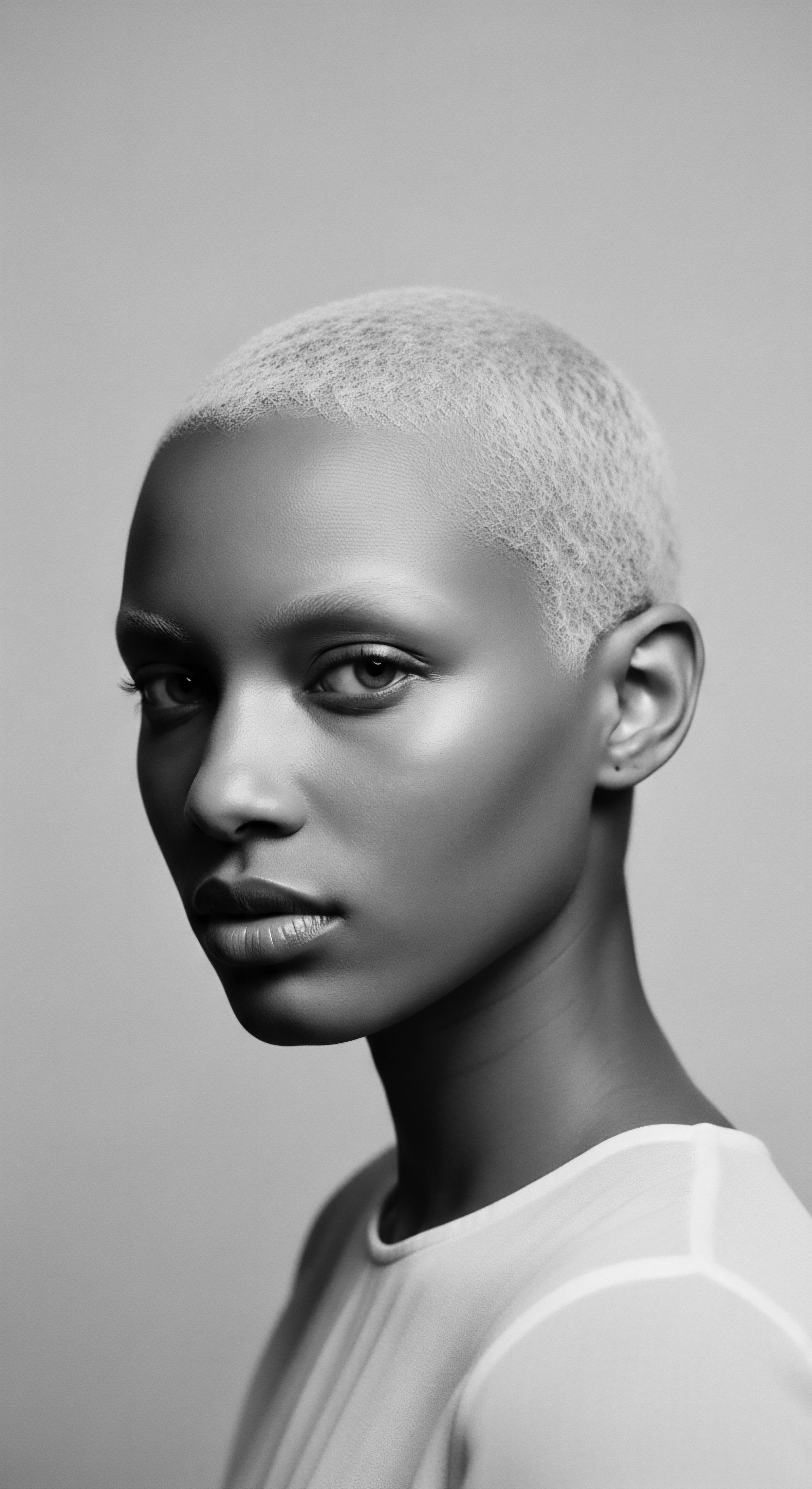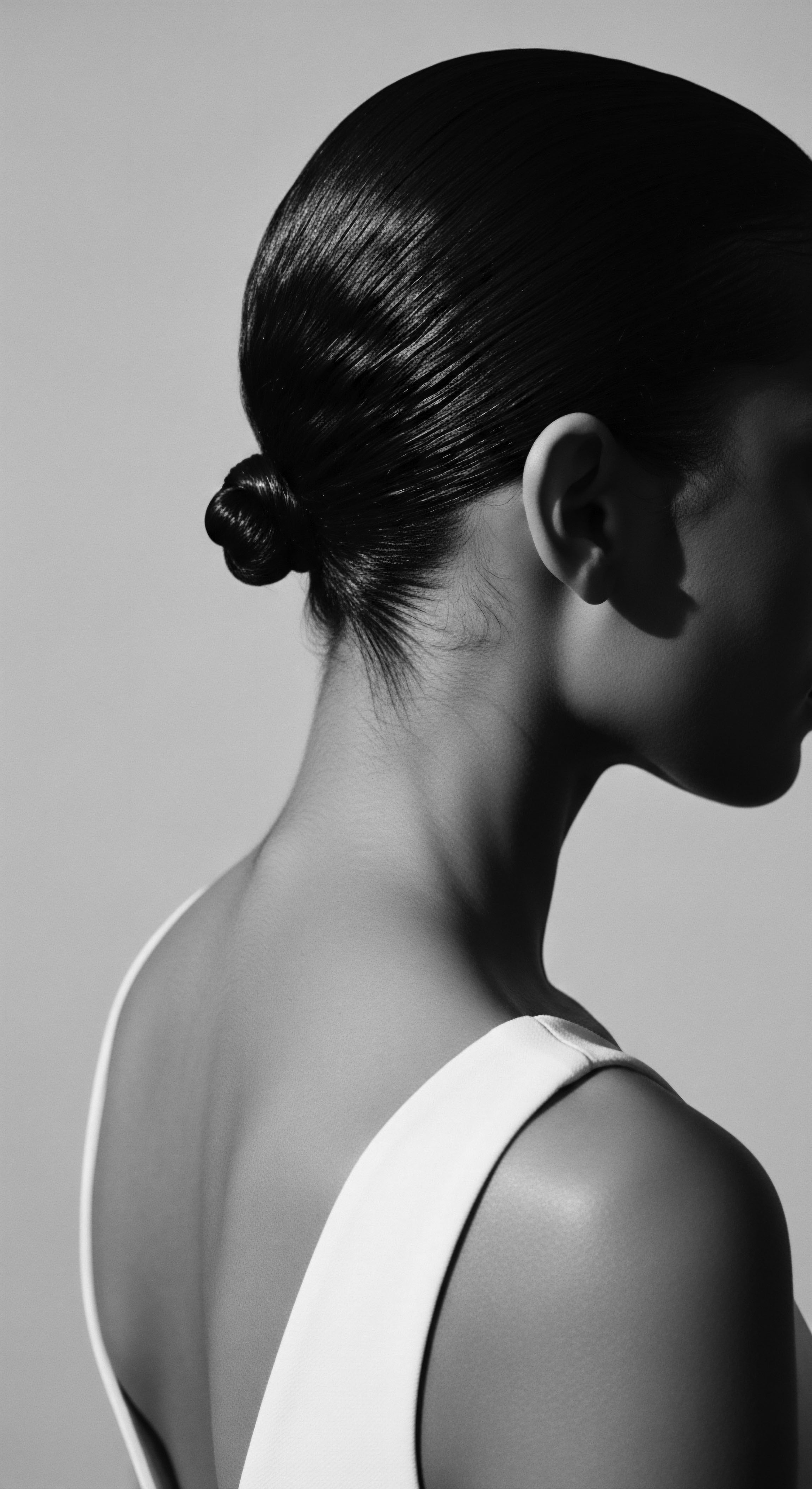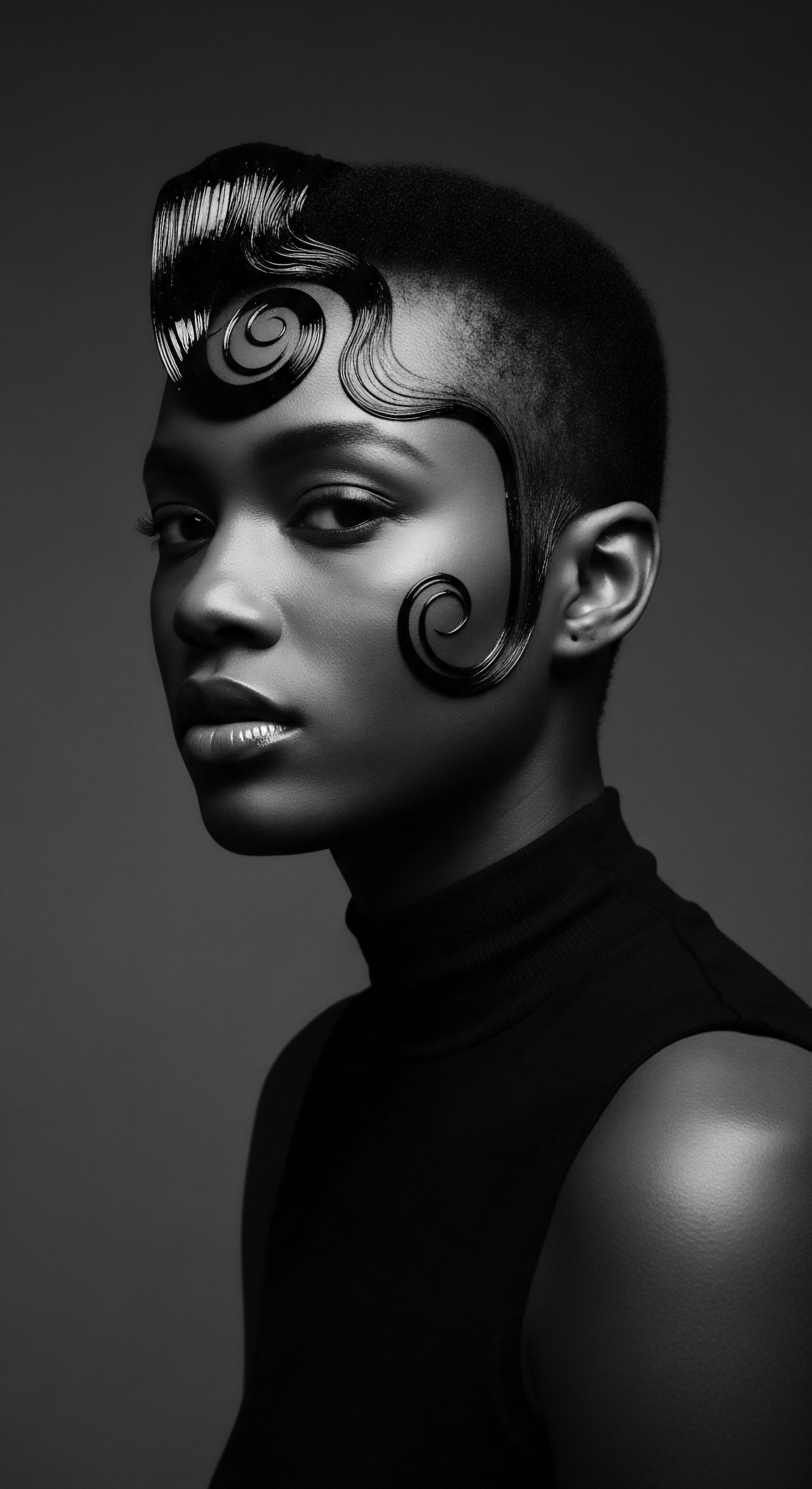
Roots
When dusk settles, and the world begins its nightly hush, a particular wisdom rises from the depths of shared experience, one as old as the cradling of coiled hair itself. It speaks of coverings, of soft fabrics chosen with intention to guard what is precious. This isn’t merely about practical care; it connects deeply to a heritage where hair holds story, identity, and resilience. For generations, the nighttime ritual of protecting textured hair has been a quiet, powerful act, a testament to understanding the unique biology of our strands and safeguarding their health against the abrasions of the world.
It’s a practice steeped in knowledge passed down, often wordlessly, through the tender touch of hands that know the ancestral wisdom of care. We consider why certain fabrics offer this particular shield for textured hair as we sleep, drawing from both the ancient echoes of tradition and the clear voice of modern scientific understanding.

The Anatomy of Coiled Strands and Ancestral Insights
To truly grasp the protective prowess of specific fabrics, we must first recognize the fundamental architecture of textured hair. Unlike straight hair, which presents a smooth, cylindrical shaft, a strand of textured hair, particularly those with tighter curl patterns, possesses a distinct elliptical shape and a cuticle layer that is more lifted and open. This structural difference, a direct evolutionary adaptation to ancestral climates, means that textured hair is naturally more susceptible to moisture loss and physical damage from friction. The very coil that grants its remarkable beauty also creates points of vulnerability.
Ancestral communities, long before the advent of modern microscopy, understood this delicate balance intuitively. Their care practices, developed over millennia across diverse African regions, reflected an inherent comprehension of moisture retention and minimizing mechanical stress. Scarves, wraps, and various hair adornments, beyond their immense cultural and social significance, served a practical purpose ❉ they mitigated the harsh effects of environmental exposure – sun, dust, and also the nightly rubbing against rough surfaces. These were not mere aesthetic choices; they were acts of survival and preservation for a vital part of self.
The coiled architecture of textured hair, an ancestral adaptation, renders it uniquely susceptible to moisture loss and friction.

The Heritage of Hair Classification
While contemporary hair typing systems (like the familiar numeric and alphabetic scales) attempt to categorize textured hair based on its curl pattern, it is important to understand that such frameworks are modern constructs. Historically, hair classification within African societies was far more nuanced and culturally embedded. Hair served as a profound identifier for tribal affiliation, marital status, age, wealth, and even spiritual beliefs. The way hair was styled, adorned, and protected reflected a complex social lexicon.
These ancestral systems, deeply connected to communal identity and heritage, guided care practices in ways that modern, purely aesthetic classifications often overlook. The understanding of how hair behaved, and therefore how to best protect it, came from generations of empirical observation within a specific cultural context.
| Historical Practices Headwraps served as cultural markers and physical shields against environmental elements and nightly abrasion in various African communities. |
| Contemporary Scientific Understanding Modern science confirms that protecting hair from environmental stressors and reducing friction are crucial for maintaining hair integrity and moisture. |
| Historical Practices Use of natural oils and butters to retain moisture, a wisdom passed through generations. |
| Contemporary Scientific Understanding Hair's natural oils and applied moisturizers are essential for preventing dryness, which cotton fabrics absorb. |
| Historical Practices Elaborate styles, often braided or twisted, protected the hair shaft from tangles and breakage during daily activities and sleep. |
| Contemporary Scientific Understanding Protective styling minimizes manipulation, a principle reinforced by the understanding of mechanical damage to the hair cuticle. |
| Historical Practices The continuity of care for textured hair reveals an enduring heritage of protective wisdom, spanning millennia. |

Ritual
The transition from day to night often carries with it a different rhythm for those with textured hair. It’s a shift from the visible expressions of identity to the intimate ritual of preservation, a practice that echoes the deep care traditions of our ancestors. The act of securing hair before slumber, whether with a carefully tied scarf or a soft bonnet, is a form of sustained self-regard that has been a quiet constant across generations. This evening practice ensures that the artistry and effort invested in styling endure, and more significantly, that the inherent wellness of the strands is shielded from the rigors of waking and resting hours.

The Protective Styling Legacy
Long before modern hair science dissected the cuticle, ancestral communities in Africa were devising methods to safeguard their hair. These practices, often seen as stylistic expressions, were deeply rooted in protective intent. Braids, Twists, and Coils were not only statements of beauty and social standing; they were also ingenious ways to minimize manipulation, reduce tangles, and retain moisture, allowing hair to thrive in diverse climates.
The very essence of protective styling lies in reducing exposure and friction, a principle that extends seamlessly to nighttime care. These methods provided a foundation for the evolution of protective coverings.
- Dukus and Doek ❉ Traditional head coverings in various African regions like Ghana and Namibia, signifying identity and used for protection.
- Gele ❉ Elaborate headwraps worn by Yoruba and Igbo women, showcasing status and providing practical hair coverage.
- Tignons ❉ Headscarves worn by free Black women in 18th-century Louisiana, initially a law of control, transformed into a symbol of resistance and style.

Which Fabrics Offer Sanctuary Overnight?
The efficacy of certain fabrics in safeguarding textured hair overnight rests largely upon their surface texture and moisture-handling properties. When textured hair, with its raised cuticles, rubs against common bedding materials like cotton, the friction created can be substantial. This mechanical agitation leads to lifted cuticles, contributing to frizz, tangles, and ultimately, breakage. Cotton, a highly absorbent fiber, also acts like a sponge, drawing essential moisture and natural oils away from the hair shaft, leaving it dry and brittle by morning.
Conversely, fabrics like silk and satin offer a different tactile experience. Their smooth, tightly woven surfaces allow hair to glide effortlessly, minimizing the friction that can disturb the delicate cuticle layer. This reduction in mechanical stress helps to preserve the hair’s external structure, resulting in less frizz and fewer tangles upon waking.
Beyond friction, the moisture retention capabilities of these materials are paramount. Unlike cotton, silk and satin are far less absorbent, allowing hair to retain its natural hydration and any applied products throughout the night. This preservation of moisture is especially important for textured hair, which is inherently prone to dryness. The choice of these fabrics, therefore, reflects a wisdom that understands both the physical vulnerability and the thirst of coiled strands.
The smooth, less absorbent nature of silk and satin minimizes friction and preserves hair’s vital moisture, unlike common cotton.

Relay
The continuity of wisdom, passed through hands and habits, reveals why certain fabrics stand as guardians of textured hair during sleep. This understanding, rooted in centuries of observation and now illuminated by scientific inquiry, forms a bridge between ancestral practices and contemporary care. We see how the choices made by our forebears, often born of necessity and deep intimacy with their hair, align remarkably with modern trichological principles concerning friction and moisture.

What Science Says About Fabric Interaction with Hair?
The science behind why specific fabrics protect textured hair overnight centers primarily on two factors ❉ the coefficient of friction and moisture absorption. Hair, at a microscopic level, is covered by a protective outer layer called the cuticle, composed of overlapping scales. When hair rubs against a rough surface, like a typical cotton pillowcase, these scales are lifted and abraded.
This friction leads to mechanical damage, manifesting as frizz, split ends, and breakage. Studies have indicated that denser fibers, such as certain polyesters and cotton, can generate higher friction coefficients against hair compared to smoother alternatives.
Conversely, silk, a natural protein fiber, and satin, a weave that results in a smooth, glossy surface (often from synthetic materials like polyester or rayon, but also silk), possess a significantly lower coefficient of friction. This translates to less resistance as hair moves during sleep. Imagine the difference between dragging a hand over sandpaper versus glass; the latter allows for effortless movement, minimizing damage to the hair’s surface.
Beyond friction, the hygroscopic properties of fabrics play a significant role. Cotton is highly absorbent; it wicks away moisture from the hair, leaving it dry and susceptible to breakage. Textured hair, by its very structure, already struggles with moisture retention because the natural oils from the scalp have difficulty traveling down the coiled shaft.
Therefore, preserving existing moisture is crucial. Silk and satin, being less absorbent, allow the hair to retain its natural hydration and any applied products, maintaining its elasticity and strength.
The 18th-century Tignon Laws in Louisiana serve as a poignant historical example of head coverings being weaponized to diminish Black women, requiring them to cover their hair publicly. Yet, these women, with remarkable spirit, transformed this oppressive decree into an act of profound resistance and beauty. They adorned their mandatory headwraps with luxurious fabrics and elaborate styles, asserting their dignity and creating coded messages within their folds, transforming a symbol of subjugation into one of pride and ingenuity.
This act, while not primarily focused on overnight protection, powerfully illustrates the resilience of Black women in leveraging fabrics to control their hair’s presentation and, by extension, their narrative, often influencing practical care practices in the process. The luxurious fabrics chosen for these acts of rebellion—silk and fine cotton—likely offered practical benefits of moisture retention and reduced friction, even if their primary purpose was symbolic.

The Science of Softness
The debate between silk and satin for hair protection is a common one, though both offer superior benefits compared to cotton. Silk is a natural protein fiber, produced by silkworms. It is breathable, hypoallergenic, and naturally smooth. Satin, while often visually similar, refers to the weave, which can be made from various fibers, including silk, nylon, or polyester.
When made from synthetic fibers, satin can offer comparable slipperiness to silk, reducing friction effectively. Both materials prevent moisture from being drawn out of the hair, preserving its hydration. The choice between them often comes down to personal preference, budget, and ethical considerations, but their shared benefit lies in their low friction coefficient and minimal moisture absorption, qualities long sought after, knowingly or intuitively, in ancestral care practices.
- Low Friction ❉ Silk and satin’s smooth surfaces allow hair to slide, reducing mechanical stress on the cuticle.
- Moisture Preservation ❉ These materials do not absorb hair’s natural oils or applied products, maintaining hydration.
- Reduced Static ❉ Less friction also means less static electricity, which can cause frizz and flyaways.
| Fabric Type Cotton |
| Surface Texture Rough, fibrous |
| Moisture Absorption High (absorbent) |
| Historical/Cultural Relevance Commonly used for daily headwraps in various cultures for sun/dust protection, but can cause friction/dryness overnight. |
| Fabric Type Silk |
| Surface Texture Smooth, natural protein fiber |
| Moisture Absorption Low (less absorbent) |
| Historical/Cultural Relevance Valued for luxuriousness and protective qualities, used in elite head coverings and emerging as a recognized hair protector. |
| Fabric Type Satin |
| Surface Texture Smooth weave (various fibers) |
| Moisture Absorption Low (less absorbent) |
| Historical/Cultural Relevance A more accessible alternative to silk, providing similar slip and moisture retention benefits for hair preservation, often used in bonnets. |
| Fabric Type The journey of fabrics for hair protection reflects a continuous refinement of materials to align with hair's biological needs, building upon ancient insights. |

Reflection
The question of why certain fabrics shield textured hair through the night resolves into a narrative far grander than mere chemistry or physics. It is a story told in the rustle of chosen cloth, in the quiet assurance of preserved coils, and in the unbroken chain of ancestral wisdom. From the resilient spirit of those who turned mandated coverings into expressions of rebellion, to the daily ritual of contemporary care, the very act of protecting textured hair overnight embodies a living archive. It whispers of adaptability, of an enduring understanding that our hair, in its magnificent complexity, requires a particular reverence.
The silk bonnet or satin scarf, seemingly simple garments, stand as enduring symbols, connecting each strand to a vast, radiant heritage. They are not merely tools; they are custodians of legacy, ensuring that the soul of each strand remains unbound, vibrant, and ready to greet the dawn, just as our ancestors intended.

References
- Byrdie. (2022). The Significance and History of Bonnets.
- Annie International, Inc. (2023). The Origin Story Of The Bonnet.
- Jackson, S. (2024). The Silk Bonnet’s History Is Rooted In Black Beauty Rituals. The Zoe Report.
- Jelani Travel. (n.d.). Head Wrap History From South Africa to Global Fashion.
- Nationalclothing.org. (2018). A short history of African headwrap.
- Schwartz, A. M. & Knowles, D. (1963). Frictional Effects in Human Hair. Journal of the Society of Cosmetic Chemists, 14(2), 67–73.
- Byrdie. (2025). Satin vs. Silk Pillowcases for Hair ❉ What’s the Difference?
- Dtex Homes. (2025). Which Pillowcase Is Better for Your Hair?
- Fouly, A. & Badran, A. (2018). A Study on the Electrostatic Charge Generated From the Friction of Wig Cap Textiles against Human Skin and Hair. ResearchGate.
